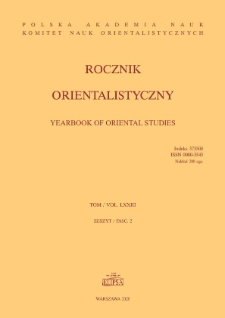Memory of Mass Persecution of Armenians and Assyrians in Four Recent Iraqi Novels
Memory of Mass Persecution of Armenians and Assyrians in Four Recent Iraqi Novels
Author(s): Adrianna MaśkoSubject(s): Christian Theology and Religion, Studies of Literature
Published by: Wydział I Nauk Humanistycznych i Społecznych Polskiej Akademii Nauk
Keywords: memory; mass persecution; Iraq; Christians in the Middle East; Armenians; Assyrians; Iraqi novel; Arabic literature
Summary/Abstract: In recent years, a number of Iraqi intellectuals have participated in a discourse on pluralism in Iraq that includes a call to address the traumatic collective experiences of the country’s ethno-religious minorities. Such a confrontation with the “wounded memory” of these minority groups – along with a rewriting of the modern history of Iraq to incorporate their stories – would be an important step in creating a new collective memory, one of cultural pluralism, that could lead to a true coexistence among all Iraqis. Since it is very difficult to carry out this process due to deep sectarian divisions within Iraqi society, literature provides an alternative cultural field for the deconstruction and reformulation of existing “master narratives”. The purpose of the article is to examine literary representations of the “wounded memory” of minorities in Iraq. The examples used here are related to the 1915–1916 Armenian genocide in the former Ottoman Empire and the 1933 massacre of Assyrians in the northern Iraqi village of Simele. They can be found in the following novels written in Arabic by Iraqi authors of Christian origin: Aṭ-Ṭuyūr al-‘amyā’ (The Blind Birds, 2016) by Laylā Qaṣrānī, Sawāqī al-qulūb (The Streams of Hearts, 2005) by In‘ām Kaǧaǧī, ‘Irāqī fī Bārīs: sīra ḏātiyya riwā’iyya (An Iraqi in Paris: An Autobiographical Novel, 2005) by Ṣamū‘īl Šam‘ūn, and Fī intiẓār Faraǧ Allāh al-Qahhār (Waiting for Farag Allah al-Qahhar, 2006) by Sa‘dī al-Māliḥ. This article is divided into three sections. An introduction is devoted to the aforementioned discourse. The second and solely descriptive section consists of three subsections focusing on literary characters who experience and/ or witness the tragic events and/or tell others about them. The third section contains concluding remarks and refers to several concepts formulated by researchers in cultural memory studies.
Journal: Rocznik Orientalistyczny
- Issue Year: 74/2021
- Issue No: 1
- Page Range: 58-94
- Page Count: 37
- Language: English

